Status Under construction Stations 2 | ||
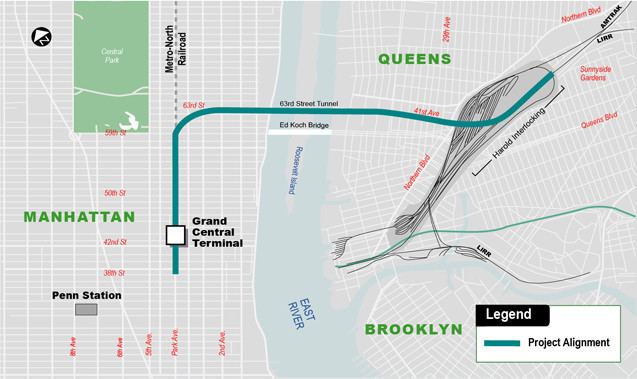 | ||
Similar | ||
A deep dive into new york s east side access project
East Side Access is a public works project being undertaken by the Metropolitan Transportation Authority (MTA) in New York City. It is designed to bring the Long Island Rail Road (LIRR) into a new East Side station to be built below, and incorporated into, Grand Central Terminal. The new terminal and connecting tracks are expected to cost $10.178 billion and are scheduled to start service in December 2022.
Contents
- A deep dive into new york s east side access project
- East side access 9 11 2015 update
- Description
- Cost considerations
- Origins
- Construction
- Manhattan side
- Queens side
- New Sunnyside station
- Jamaica Platform F
- Main Line third track
- Controversy
- References
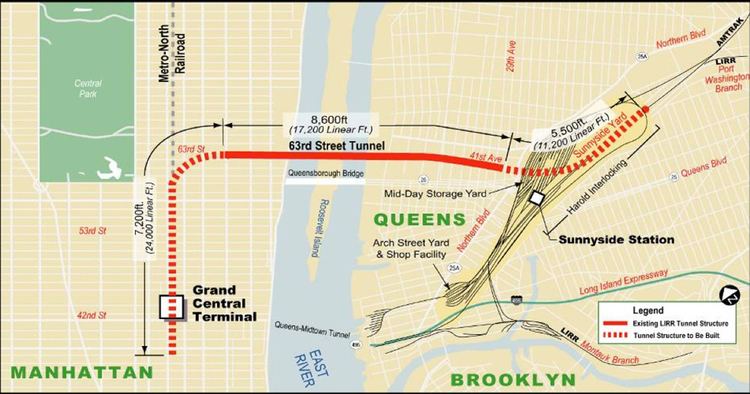
East side access 9 11 2015 update
Description
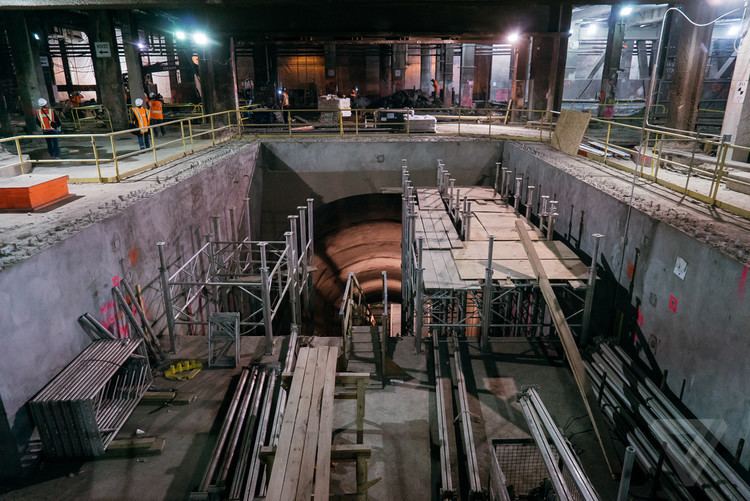
Extending between Sunnyside, Queens, and Grand Central, the project will route the LIRR from its Main Line through new track connections in Sunnyside Yard and through the lower level of the existing 63rd Street Tunnel under the East River. In Manhattan, a new tunnel will begin at the western end of the 63rd Street Tunnel at Second Avenue, curving south under Park Avenue and entering a new LIRR terminal beneath Grand Central.

The new LIRR terminal at Grand Central, located 14 stories below ground, will feature a total of four platforms and eight tracks, plus a new 350,000-square-foot retail and dining concourse. It will initially be accessed via stairwells, 22 elevators, and 47 escalators connecting to Grand Central's existing food court, in comparison to the 19 escalators in the remainder of the LIRR system. The MTA plans to build and open additional entrances at 45th, 46th, and 48th streets. The escalators would be up to 180 feet (55 m) long and descend more than 90 feet (27 m). The escalators and elevators are to be partially privately operated, one of the only such instances in the entire MTA system.
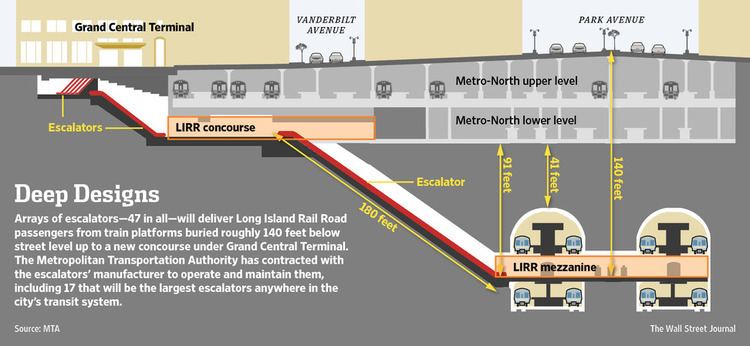
Current plans call for 24-trains-per-hour service to Grand Central during peak morning hours, with an estimated 162,000 passenger trips to and from Grand Central on an average weekday. Connections to AirTrain JFK at Jamaica Station in Jamaica, Queens, will facilitate travel to John F. Kennedy International Airport from the East Side of Manhattan. However, the tunnels of the East Side Access can only be used by M3, M7, and M9 railcars due to a height restriction created when the 63rd Street Tunnel was first built. C3 railcars and EMD DE30AC and DM30AC locomotives will not be able to use the tunnels.
Cost considerations

The project's estimated cost has increased from $4.3 billion when first proposed, to $6.3 billion in 2006, $8.4 billion in 2012, and $10.8 billion in 2014. Though construction work is ongoing, the completion date for the project has been continually pushed back by the MTA. Once planned to be operational by 2009, the MTA has pushed back the completion date several times, most recently to September 2023. Previous projections for the terminal were for it to open as soon as 2019. With the fourteen-year delay in the completion date and the 150% cost increase to $10.8 billion, the USDOT Inspector General wants an audit done on the project.
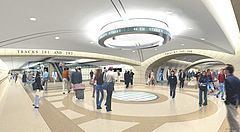
The project is likely to increase passenger loads on the already overcrowded IRT Lexington Avenue Line and on surface bus routes on the East Side. It will share the 63rd Street station with the Second Avenue Subway, opened in 2017, with service to 96th Street and Second Avenue. At the same time, the project will reduce the load on rush-hour E train service between Pennsylvania Station and Midtown East and 7 train service across the East River.
Origins
The project started as part of the MTA's Program for Action, a 1968 plan proposing numerous improvements to subway, railway, and airport service in the New York metropolitan area. The plan included a new LIRR terminal at a proposed Metropolitan Transportation Center at Third Avenue and 48th Street in East Midtown. It would include connections to Grand Central Terminal, which would have a new northern entrance leading to the center, and the also-proposed Second Avenue Subway, among other transit services. The new LIRR line would branch off from existing lines in Sunnyside, Queens and enter Manhattan using a new two-level tunnel under 63rd Street; the upper level would be used by the New York City Subway's 63rd Street Line and the lower level would be used the LIRR. Construction on the tunnel began in November 1969; the MTA's contractor floated pre-manufactured four-chamber tunnel boxes into place in the East River and sank them to create the East River crossings for the subway and the LIRR. Construction costs would be offset by building office space above the transportation center. There would be a mezzanine above the four island platforms and eight tracks, which were split evenly across two levels; this is similar to the structure currently under construction. By late 1974, the finishing date for East Side Access was set to 1993.
Construction on the lower level of the 63rd Street tunnel was completed along with the upper subway level. However, due to New York City's financial crises of the 1970s, the LIRR project had been canceled long before the tunnel was completed. In 1976, the New York Times noted that the lower level of the 63rd Street tunnel was still under construction, even though "officials knew that the tunnel would never be used." Richard Ravitch, the MTA chairman, said that to stop the work was impossible or so costly as to make it impractical subsequent to the construction of the subway portion." The 8,600 feet (2,600 m) "tunnel to nowhere" was completed "largely for structural reasons — to support the subway tunnel above." The 63rd Street subway line and LIRR tunnel were completed to as far as 21st Street in Long Island City, Queens, with the subway level of the tunnel opening in 1989. The LIRR tracks sat unused beneath the active subway tracks. Between 1995 and 2001, the 63rd Street subway tunnel was extended east to connect to the Queens Boulevard subway line; the LIRR tunnel was also extended east, under 41st Avenue in Queens to the west side of Northern Boulevard in Queens. The western end of this tunnel lay dormant under Second Avenue at 63rd Street for three decades. By the time that construction on the LIRR tunnel level stopped, the tunnel was built for a distance of 8,600 feet (2,600 m).
Construction
The project represents the construction effort to complete the line to Grand Central. After voters in New York approved a bond issue to provide state funds to the project, the federal government committed to provide $2.6 billion to help build the project by signing a Full Funding Grant Agreement in December 2006. The construction contract for a 1 mile (2 km) tunnel in Manhattan west and southward from the dormant lower level of the 63rd Street rail tunnel to the new 100-foot-deep (30 m) station beneath Grand Central was awarded on July 13, 2006, to Dragados/Judlau, a joint American–Spanish venture (the American company is located in College Point, Queens). The total contract award is $430 million, and is using two large tunneling devices owned by the Spanish firm.
Manhattan side
Work on the Manhattan side includes building a new 8-track train station deep underground and connecting it to the 63rd Street Tunnel's lower level. The new station will be housed in two gigantic caverns blasted out of the Manhattan schist rock formation that underlies the station. A three level structure is being built in each cavern, with a train platform and two tracks each on the top and bottom levels and a passenger concourse in the middle. The middle levels in the two caverns will be connected by passageways and the west cavern, in turn, will be connected by banks of escalators and elevators to a new concourse being constructed on the lower level of Grand Central Terminal. That concourse will replace ten tracks on the west side of GCT's Madison Yard. The track connections from the new station to the 63rd Street Tunnel were excavated using tunnel boring machines (TBMs).
Dragados/Judlau created a launch chamber for the tunnel boring machines (TBMs) under Second Avenue at 63rd Street using a controlled drill-and-blast method, then assembled and launched each 640-ton machine. The first TBM was launched west and southbound from the 63rd Street tunnel in September 2007 and reached Grand Central in July 2008. The second machine began boring a parallel tunnel in December 2007 and had completed its tunnel at 37th Street on September 30, 2008. Geocomp Corporation was hired to monitor the boring, using a battery of instruments to record vibration, ground settlement and any tilting or drift suffered by the TBM. The instruments include inclinometers, extensometers, seismographs, observation wells, dynamic strain gauges, tilt meters and automated motorized total stations (AMTS) with prismatic targets. The next step in construction is to back the TBMs out of the tunnels and cast-in-place concrete sections placed to create the lining. Each tunnel will be 22 feet (7 metres) in diameter and carry trains 140 feet (43 metres) beneath street level. The TBMs bored an average of 50 feet (15 metres) per day. Cross-connections between the tunnels are being created under Park Avenue, between 49th and 51st Streets, by controlled drill-and-blast; the work began in mid-July 2008 and was expected to require between six and eight months to complete.
As of June 2011, eight station tunnels under Grand Central – where trains will berth at platforms – were fully bored, and station excavation was still underway. After the TBMs finished drilling through the Grand Central station box, they were left in place under 38th Street and Park Avenue, as it was more economical than disassembling the TBMs in Queens and selling them for scrap, which could have added $9 million to the project's final cost.
On September 16, 2014, MTA opened a 2,400 square feet (220 m2) pocket park at 48 East 50th Street between Madison and Park Avenues, created along with the $97 million ventilation facility; the latter is not yet operational, but the former has a capacity of 100 standees, or 40 people sitting down. The park, containing a lot of greenery along a granite backdrop with tables and chairs, is meant to reduce noise pollution from the ventilation facility, which is also an emergency exit.
On October 26, 2015, a 1,920-square-foot (178 m2) seating area in Grand Central Terminal’s Lower Level Dining Concourse was closed in order to build structural framework that will allow for the future construction of stairways and escalators that will connect Grand Central’s Lower Level to the Long Island Rail Road concourse and terminal underneath Grand Central Terminal. This was deemed as a major milestone in the construction of East Side Access by Dr. Michael Horodniceanu, the President of MTA Capital Construction. On November 10, 2015, a groundbreaking ceremony was held to celebrate the emergence of the project into Grand Central Terminal.
On January 27, 2016, the final major contract for the construction of East Side Access was awarded to Tutor Perini Corporation. The contract was for the construction of four railroad platforms and eight tracks for the new Grand Central terminal.
Queens side
Previous work extending subway service through the upper level of the 63rd Street Tunnel to lines in Queens also extended the lower level to a point west of Northern Boulevard, across from the Sunnyside Yard. Work in Queens included extending the tunnel under Northern Boulevard, a particularly delicate and expensive task due to subway lines above, boring four tunnels under Sunnyside yard and connecting three of them to the busy Harold Interlocking. (The fourth tunnel will connect to a storage and maintenance area.) In addition, the existing tunnel bell mouth west of Northern Boulevard was expanded to serve as the staging area for the Manhattan work, bringing in workers, equipment and supplies and bringing out the muck and debris from excavation. A temporary narrow-gauge railway and a conveyor belt system were constructed behind the TBMs and through the 63rd Street Tunnels to the Queens bell mouth. Due to its shape, the Queens work site was nicknamed the Q-tip.
Pile Foundation Construction Company built an $83 million open-cut and deck project, which extends the tracks under Northern Boulevard into Sunnyside Yard, and creates an area that served as both the launch chamber for soft-bore Queens tunnels, connecting the 63rd Street line to the main LIRR branches, and an interlocking and emergency exit and venting facility. Perini Corporation was awarded a $161 million contract to reconfigure Harold Interlocking, increasing its capacity to accommodate Grand Central-bound trains and accept new yard lead tracks to allow trains to enter the storage yards. On February 15, 2008, the MTA awarded Dragados-Judlau a $499 million contract to excavate the LIRR station and track wye caverns. On September 10, 2009, the MTA awarded Yonkers Contracting Company a $40.76 million contract to demolish a building at 44th Street and construct a ventilation plant and station entrance. On September 28, 2009, the MTA awarded Granite-Traylor-Frontiere Joint Venture a $659.2 million contract to employ two 500-ton slurry TBMs to create the tunnels which will connect the LIRR main line and the Port Washington Branch to the tunnel under 41st Avenue (the 63rd Street tunnel). Four tunnels, with precast concrete liners, will total two miles (three kilometers) in length.
These two TBMs began tunneling in April 2011. On December 22, 2011, breakthrough was achieved in Tunnel "A" of the four Queens tunnel drives from the 63rd Street tunnel bellmouth. On July 25, 2012, all four Queens tunnel drives were complete. In April 2014, contracts were awarded for the final modifications for the tunnels, as well as for communication systems.
New Sunnyside station
A new LIRR train station in Sunnyside at Queens Boulevard and Skillman Avenue along the Northeast Corridor (which the LIRR uses to get into Pennsylvania Station) will be built, which will provide one-stop access for area residents to Midtown Manhattan.
Jamaica Platform F
A new Platform F is being constructed south of the existing LIRR platforms at Jamaica station, which, along with yard and track improvements, will increase capacity and facilitate service to Brooklyn by eliminating crossovers and converting the section of the Atlantic Branch from Jamaica to the Atlantic Terminal into a shuttle service. Completion is projected for July 2019.
Main Line third track
Related to the MTA's East Side Access project is its long-planned widening of the two-track LIRR Main Line by adding a third track. Completion of Main Line third track construction was assumed during East Side Access project planning and referenced in the original East Side Access environmental impact statement as necessary to support service level increases caused by adding service to and from Grand Central. The MTA has said that it considers the Main Line third track an "essential" project to support East Side Access, and that the Main Line third track will "complement the East Side Access megaproject, which is doubling the LIRR’s capacity into Manhattan."
Main Line third track construction was deferred indefinitely by the MTA in 2008 due to budget constraints. In January 2016, Governor Cuomo and the MTA announced plans to restart construction of the Main Line third track. As of February 2016, an expected completion date has not been announced for the Main Line third track.
Controversy
Given the massive size of the project, the plan has aroused concerns and opposition. For example, in 2005, businesses and Catholic Archbishop, Cardinal Edward Egan, began to express concerns about the tunneling process. Egan in particular was concerned about the impact on St. Patrick's Cathedral, which faces Fifth Avenue with its back on Madison Avenue north of 50th Street. The project is proposing that an air vent be placed south of 50th Street and east of Madison Avenue, just outside the existing train shed. The contract for the 50th Street air vent was awarded by the end of 2011, and as of May 2012 construction of the vent was underway. The vent was finished in September 2014.
